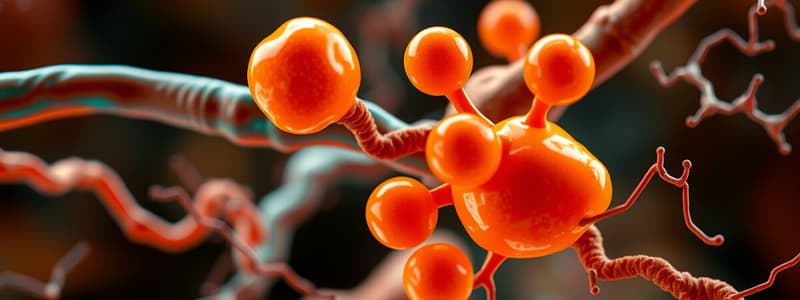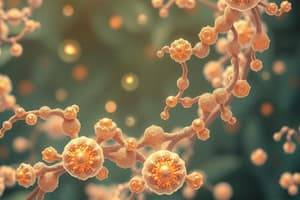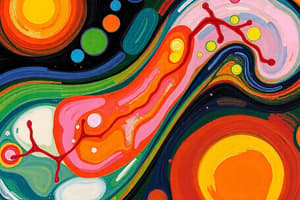Podcast
Questions and Answers
What is the primary role of bile salts in fat digestion?
What is the primary role of bile salts in fat digestion?
- To hydrolyze triacylglycerol directly.
- To produce monoacylglycerol from glycerol.
- To emulsify fats into micelles for enzyme action. (correct)
- To absorb vitamins A, D, E, and K directly.
Which component is primarily hydrolyzed by pancreatic lipase during fat digestion?
Which component is primarily hydrolyzed by pancreatic lipase during fat digestion?
- Glycerol.
- Fatty acids.
- Ester links in triacylglycerol. (correct)
- Monoacylglycerol.
What occurs to monoglycerides and fatty acids after they have been emulsified by bile salts?
What occurs to monoglycerides and fatty acids after they have been emulsified by bile salts?
- They are directly absorbed by the blood.
- They dissociate into individual lipid molecules.
- They must first form mixed micelles for absorption. (correct)
- They form stable interactions with bile salts in the intestinal lumen.
How does a low concentration of bile salts affect fat absorption in the small intestine?
How does a low concentration of bile salts affect fat absorption in the small intestine?
What is the primary form of lipid stored in mammals?
What is the primary form of lipid stored in mammals?
Which particles are incorporated into bile salt micelles for transport in the intestinal lumen?
Which particles are incorporated into bile salt micelles for transport in the intestinal lumen?
Which of the following components are essential for the digestion and intestinal absorption of lipids?
Which of the following components are essential for the digestion and intestinal absorption of lipids?
What is the role of bile acids in lipid digestion?
What is the role of bile acids in lipid digestion?
What can lead to a reduced concentration of bile salts in the intestinal lumen?
What can lead to a reduced concentration of bile salts in the intestinal lumen?
What diameter do bile salts help form for emulsified fat particles?
What diameter do bile salts help form for emulsified fat particles?
How do dietary fats generally reach adipose tissue after ingestion?
How do dietary fats generally reach adipose tissue after ingestion?
What structural feature of bile salts allows them to interact with both lipids and water?
What structural feature of bile salts allows them to interact with both lipids and water?
What is the fate of bile salts after emulsifying fats in the intestinal lumen?
What is the fate of bile salts after emulsifying fats in the intestinal lumen?
Which process increases the accessibility of lipids to digestive enzymes?
Which process increases the accessibility of lipids to digestive enzymes?
What percentage of a mammal's body weight can be lipid?
What percentage of a mammal's body weight can be lipid?
What is primarily responsible for the poor water solubility of lipids?
What is primarily responsible for the poor water solubility of lipids?
What are chylomicrons primarily composed of?
What are chylomicrons primarily composed of?
How are triacylglycerols transported to tissues?
How are triacylglycerols transported to tissues?
What triggers the mobilization of fatty acids from triglyceride deposits in adipose tissue?
What triggers the mobilization of fatty acids from triglyceride deposits in adipose tissue?
Which hormone inhibits the mobilization of fats when present in high concentrations?
Which hormone inhibits the mobilization of fats when present in high concentrations?
What happens to triacylglycerols at the cell surface?
What happens to triacylglycerols at the cell surface?
What would occur if the concentration of insulin is lower than glucagon and adrenalin?
What would occur if the concentration of insulin is lower than glucagon and adrenalin?
What is a result of the absorption of fatty acids into intestinal epithelial cells?
What is a result of the absorption of fatty acids into intestinal epithelial cells?
What is the primary function of apolipoprotein in chylomicrons?
What is the primary function of apolipoprotein in chylomicrons?
Flashcards are hidden until you start studying
Study Notes
Lipid Metabolism Overview
- Importance of Lipids: Essential for energy metabolism, structural roles, and biological functions.
- Triacylglycerols: Constitute 90% of body lipids in mammals, primarily stored in adipose tissue.
Dietary Fat Ingestion
- Daily Fat Intake: An adult man consumes approximately 60-100g of dietary fat daily, with triacylglycerides making up over 90% of this fat.
- Lipids Composition: Dietary fats also include phospholipids, cholesterol, cholesterol esters, and free fatty acids.
Digestion of Dietary Fats
- Solubility of Lipids: Lipids are poorly soluble in water, creating challenges for digestion and absorption.
- Role of Bile Salts: Essential for lipid digestion; they emulsify fats and enhance the interface between lipid and aqueous phases.
- Bile Salt Composition: Synthesized from cholesterol, bile salts (such as glycocholic and taurocholic acid) contain both hydrophobic and hydrophilic surfaces.
Mechanism of Lipid Digestion
- Emulsification Process: Bile salts create micelles, allowing the digestion of triacylglycerols by water-soluble enzymes like pancreatic lipase.
- Product Formation: Triacylglycerols are broken down into monoacylglycerol and free fatty acids.
- Micelle Formation: Mixed micelles facilitate the transport of lipids to intestinal epithelium for absorption.
Clinical Implications
- Bile Salt Deficiency: Low bile salt concentrations can lead to decreased fat absorption (steatorrhoea) and fat-soluble vitamin deficiencies (A, D, E, K).
- Dietary Management: Patients with insufficient bile salts may need low-fat diets and vitamin supplementation via injection.
Absorption and Transport of Lipids
- Triacylglycerol Re-esterification: Fatty acids absorbed into intestinal epithelial cells are re-esterified into triacylglycerols.
- Formation of Chylomicrons: These are large lipoprotein particles consisting primarily of triacylglycerols (approximately 85%), phospholipids, cholesterol, and apolipoproteins.
- Transport Mechanism: Chylomicrons enter the bloodstream, delivering dietary lipids to the liver and adipose tissue; they are cleaved by lipoprotein lipase to release free fatty acids and glycerol.
Mobilization of Stored Fat
- Hormonal Influence: Fatty acid mobilization from adipose tissue is regulated by hormones, primarily influenced by insulin during high-glucose conditions.
- Glycogenesis vs. Lipolysis: Elevated insulin promotes lipid synthesis while inhibiting lipolysis, shifting the body towards using glucose for energy instead of stored fats.
Studying That Suits You
Use AI to generate personalized quizzes and flashcards to suit your learning preferences.




